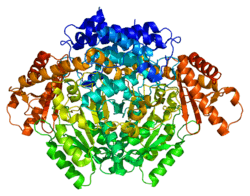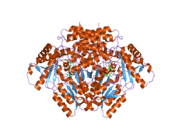GAD1
| View/Edit Human | View/Edit Mouse |
Glutamate decarboxylase 1 (brain, 67kDa) (GAD67), also known as GAD1, is a human gene.[3]
This gene encodes one of several forms of glutamic acid decarboxylase, identified as a major autoantigen in insulin-dependent diabetes. The enzyme encoded is responsible for catalyzing the production of gamma-aminobutyric acid from L-glutamic acid. A pathogenic role for this enzyme has been identified in the human pancreas since it has been identified as an autoantigen and an autoreactive T cell target in insulin-dependent diabetes. This gene may also play a role in the stiff man syndrome. Deficiency in this enzyme has been shown to lead to pyridoxine dependency with seizures. Alternative splicing of this gene results in two products, the predominant 67-kD form and a less-frequent 25-kD form.[3]
Interactions
GAD1 has been shown to interact with GAD2.[4]
See also
References
- ↑ "Human PubMed Reference:".
- ↑ "Mouse PubMed Reference:".
- 1 2 "Entrez Gene: GAD1 glutamate decarboxylase 1 (brain, 67kDa)".
- ↑ Dirkx R, Thomas A, Li L, Lernmark A, Sherwin RS, De Camilli P, Solimena M (February 1995). "Targeting of the 67-kDa isoform of glutamic acid decarboxylase to intracellular organelles is mediated by its interaction with the NH2-terminal region of the 65-kDa isoform of glutamic acid decarboxylase". J. Biol. Chem. 270 (5): 2241–6. doi:10.1074/jbc.270.5.2241. PMID 7836456.
Further reading
- Kelly CD, Edwards Y, Johnstone AP, Harfst E, Nógrádi A, Nussey SS, Povey S, Carter ND (1992). "Nucleotide sequence and chromosomal assignment of a cDNA encoding the large isoform of human glutamate decarboxylase". Ann. Hum. Genet. 56 (Pt 3): 255–65. doi:10.1111/j.1469-1809.1992.tb01150.x. PMID 1339255.
- Bu DF, Erlander MG, Hitz BC, Tillakaratne NJ, Kaufman DL, Wagner-McPherson CB, Evans GA, Tobin AJ (1992). "Two human glutamate decarboxylases, 65-kDa GAD and 67-kDa GAD, are each encoded by a single gene". Proc. Natl. Acad. Sci. U.S.A. 89 (6): 2115–9. doi:10.1073/pnas.89.6.2115. PMC 48607
 . PMID 1549570.
. PMID 1549570. - Giorda R, Peakman M, Tan KC, Vergani D, Trucco M (1991). "Glutamic acid decarboxylase expression in islets and brain". Lancet. 338 (8780): 1469–70. doi:10.1016/0140-6736(91)92781-V. PMID 1683463.
- Persson H, Pelto-Huikko M, Metsis M, Söder O, Brene S, Skog S, Hökfelt T, Ritzén EM (1990). "Expression of the neurotransmitter-synthesizing enzyme glutamic acid decarboxylase in male germ cells". Mol. Cell. Biol. 10 (9): 4701–11. PMC 361065
 . PMID 1697032.
. PMID 1697032. - Cram DS, Barnett LD, Joseph JL, Harrison LC (1991). "Cloning and partial nucleotide sequence of human glutamic acid decarboxylase cDNA from brain and pancreatic islets". Biochem. Biophys. Res. Commun. 176 (3): 1239–44. doi:10.1016/0006-291X(91)90418-7. PMID 2039509.
- Dirkx R, Thomas A, Li L, Lernmark A, Sherwin RS, De Camilli P, Solimena M (1995). "Targeting of the 67-kDa isoform of glutamic acid decarboxylase to intracellular organelles is mediated by its interaction with the NH2-terminal region of the 65-kDa isoform of glutamic acid decarboxylase". J. Biol. Chem. 270 (5): 2241–6. doi:10.1074/jbc.270.5.2241. PMID 7836456.
- Bu DF, Tobin AJ (1994). "The exon-intron organization of the genes (GAD1 and GAD2) encoding two human glutamate decarboxylases (GAD67 and GAD65) suggests that they derive from a common ancestral GAD". Genomics. 21 (1): 222–8. doi:10.1006/geno.1994.1246. PMID 8088791.
- Yamashita K, Cram DS, Harrison LC (1993). "Molecular cloning of full-length glutamic acid decarboxylase 67 from human pancreas and islets". Biochem. Biophys. Res. Commun. 192 (3): 1347–52. doi:10.1006/bbrc.1993.1564. PMID 8507202.
- Kawasaki E, Moriuchi R, Watanabe M, Saitoh K, Brunicardi FC, Watt PC, Yamaguchi T, Mullen Y, Akazawa S, Miyamoto T (1993). "Cloning and expression of large isoform of glutamic acid decarboxylase from human pancreatic islet". Biochem. Biophys. Res. Commun. 192 (3): 1353–9. doi:10.1006/bbrc.1993.1565. PMID 8507203.
- Asada H, Kawamura Y, Maruyama K, Kume H, Ding R, Ji FY, Kanbara N, Kuzume H, Sanbo M, Yagi T, Obata K (1996). "Mice lacking the 65 kDa isoform of glutamic acid decarboxylase (GAD65) maintain normal levels of GAD67 and GABA in their brains but are susceptible to seizures". Biochem. Biophys. Res. Commun. 229 (3): 891–5. doi:10.1006/bbrc.1996.1898. PMID 8954991.
- McHale DP, Mitchell S, Bundey S, Moynihan L, Campbell DA, Woods CG, Lench NJ, Mueller RF, Markham AF (1999). "A gene for autosomal recessive symmetrical spastic cerebral palsy maps to chromosome 2q24-25". Am. J. Hum. Genet. 64 (2): 526–32. doi:10.1086/302237. PMC 1377761
 . PMID 9973289.
. PMID 9973289. - Chessler SD, Lernmark A (2000). "Alternative splicing of GAD67 results in the synthesis of a third form of glutamic-acid decarboxylase in human islets and other non-neural tissues". J. Biol. Chem. 275 (7): 5188–92. doi:10.1074/jbc.275.7.5188. PMID 10671565.
- Luo J, Kaplitt MG, Fitzsimons HL, Zuzga DS, Liu Y, Oshinsky ML, During MJ (2002). "Subthalamic GAD gene therapy in a Parkinson's disease rat model". Science. 298 (5592): 425–9. doi:10.1126/science.1074549. PMID 12376704.
- Chessler SD, Hampe CS, Ortqvist E, Simonson WT, Bekris L (2002). "Immune reactivity to GAD25 in type 1 diabetes mellitus". Autoimmunity. 35 (5): 335–41. doi:10.1080/0891693021000005402. PMID 12515288.
- Demakova EV, Korobov VP, Lemkina LM (2003). "[Determination of gamma-aminobutyric acid concentration and activity of glutamate decarboxylase in blood serum of patients with multiple sclerosis]". Klin. Lab. Diagn. (4): 15–7. PMID 12774663.
- Flace P, Benagiano V, Lorusso L, Girolamo F, Rizzi A, Virgintino D, Roncali L, Ambrosi G (2004). "Glutamic acid decarboxylase immunoreactive large neuron types in the granular layer of the human cerebellar cortex". Anat. Embryol. 208 (1): 55–64. doi:10.1007/s00429-003-0374-x. PMID 15014985.
- De Luca V, Muglia P, Masellis M, Jane Dalton E, Wong GW, Kennedy JL (2004). "Polymorphisms in glutamate decarboxylase genes: analysis in schizophrenia". Psychiatr. Genet. 14 (1): 39–42. doi:10.1097/00041444-200403000-00006. PMID 15091314.
- Kanno K, Suzuki Y, Yamada A, Aoki Y, Kure S, Matsubara Y (2004). "Association between nonsyndromic cleft lip with or without cleft palate and the glutamic acid decarboxylase 67 gene in the Japanese population". Am. J. Med. Genet. A. 127A (1): 11–6. doi:10.1002/ajmg.a.20649. PMID 15103710.
This article incorporates text from the United States National Library of Medicine, which is in the public domain.




